4.3. The Himalayan Drainage System
The Himalayan drainage system has evolved through a long geological history. There is no unanimity among geologists about the origin of the Himalayan rivers. However, it is believed that a mighty river, namely Shiwalik or Indo-Brahma was flowing west from Assam to Sind and finally discharged into Gulf of Sind during Miocene period. The remarkable continuity of the Shiwalik and its lacustrine origin and alluvial deposits consisting of sands, silt, clay, boulders and conglomerates support this viewpoint.
This mighty Shiwalik river was dismembered into three main systems which are now called as Indus, Ganga and Brahmaputra systems (figure 19).The dismemberment is attributed to upheaval in the Western Himalayas including uplift of the Potwar Plateau (or Delhi Ridge). This ridge act as a water divide between Indus and Ganga river systems. Similarly, the down thrusting of the Malda fault (area between Rajmahal Hills and the Meghalaya Plateau) caused the Ganga and the Brahamputra systems to flow towards Bay of Bengal. The giant gorges, sudden bends towards South and other such features are evidence in support that these rivers are older than the Himalayas.

